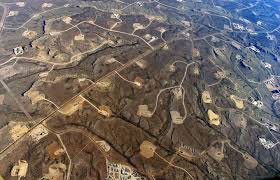As EPA prepared to release regulations on methane emissions from fracking, a lawsuit was filed to get the agency to address the industry’s other big problem – waste.
Every well – and there are tens of thousands in the US – generates millions of gallons of wastewater filled with toxic chemicals and hundreds of tons of fracking debris.
“Right now, companies can get rid of their toxic mess in any number of dangerous ways – from spraying it on icy roads, to sending it to landfills with our everyday household trash, to injecting it underground where it can endanger drinking water and trigger earthquakes. EPA must step in and protect our communities and drinking water from the carcinogens, radioactive material and other dangerous substances that go hand-in-hand with oil and gas waste,” says Amy Mall, senior policy analyst at Natural Resources Defense Council (NRDC), one of the plaintiffs in the lawsuit.
Fracking pads in Wyoming:
The lawsuit asks the US District Court, District of Columbia, to:
- set strict deadlines for EPA to update waste disposal rules.
- urge EPA to ban the practice of spreading fracking wastewater onto roads or fields, which allows toxic pollutants to run off and contaminate streams.
- EPA should require landfills and ponds that receive drilling and fracking waste to be built with adequate liners and structural integrity to prevent spills and leaks into groundwater and streams.
Under the Resource Conservation and Recovery Act, EPA is required to review and update federal regulations on oil and gas waste every three years, but these are 25 years overdue.
Meanwhile …
Unregulated wastewater disposal has resulted in Ohio and Oklahoma becoming earthquake zones, with the latter experiencing several earthquakes every day now.
“A major reason for the industry’s use of injection wells to dispose of toxic fracking waste is the low disposal cost,” says Teresa Mills, at the Center for Health, Environment and Justice.
Water – filled with toxic chemicals is dumped or spilled into countless streams in many states. Last year, in North Dakota, for example, 3 million gallons spewed from a leaking pipe into a tributary of the Missouri River.
Drill cuttings that contain high levels of radiation make it into landfillsthat are not constructed to handle hazardous waste, across the Marcellus region, for example. It can leach into the groundwater.
Texas Floods, North Dakota Spills
During the recent floods in Texas, oil wells and fracking sites were inundated, flushing oil and toxic chemicals into rivers. Photos show sheens and plumes spreading from tipped tanks and flooded production sites, reports the Statesman.
“That’s a potential disaster. Cattle died within an hour of drinking the water and there are potential carcinogens that can lead to leukemia, brain cancer and other endocrine disruptors, Dr. Walter Tsou, past president of the American Public Health Association, told El Paso Times.
In North Dakota, even after cleaning up spills, the legacy of radioactivity in the soil remains, where it could last for thousands of years, reportsInsideClimate News. More than 4,000 spills have occurred in North Dakota since 2001, prompting the state to finally craft more stringent rules for building and monitoring wastewater pipelines.

